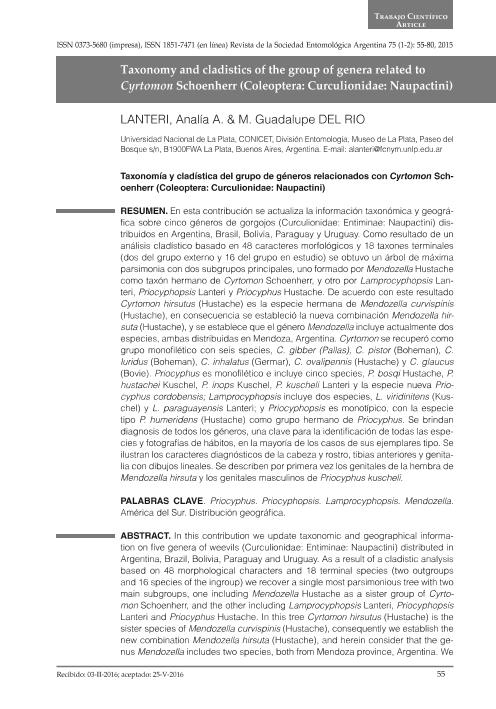Mostrar el registro sencillo del ítem
dc.contributor.author
Lanteri, Analia Alicia

dc.contributor.author
del Rio, Maria Guadalupe

dc.date.available
2020-10-07T17:43:38Z
dc.date.issued
2016-06
dc.identifier.citation
Lanteri, Analia Alicia; del Rio, Maria Guadalupe; Taxonomy and cladistics of the group of genera related to Cyrtomon Schoenherr (Coleoptera: Curculionidae: Naupactini); Sociedad Entomológica Argentina; Revista de la Sociedad Entomológica Argentina; 75; 1-2; 6-2016; 55-80
dc.identifier.issn
0373-5680
dc.identifier.uri
http://hdl.handle.net/11336/115556
dc.description.abstract
En esta contribución se actualiza la información taxonómica y geográfica sobre cinco géneros de gorgojos (Curculionidae: Entiminae: Naupactini) distribuidos en Argentina, Brasil, Bolivia, Paraguay y Uruguay. Como resultado de un análisis cladístico basado en 48 caracteres morfológicos y 18 taxones terminales (dos del grupo externo y 16 del grupo en estudio) se obtuvo un árbol de máxima parsimonia con dos subgrupos principales, uno formado por Mendozella Hustache como taxón hermano de Cyrtomon Schoenherr, y otro por Lamprocyphopsis Lanteri, Priocyphopsis Lanteri y Priocyphus Hustache. De acuerdo con este resultado Cyrtomon hirsutus (Hustache) es la especie hermana de Mendozella curvispinis (Hustache), en consecuencia se estableció la nueva combinación Mendozella hirsuta (Hustache), y se establece que el género Mendozella incluye actualmente dos especies, ambas distribuidas en Mendoza, Argentina. Cyrtomon se recuperó como grupo monofilético con seis species, C. gibber (Pallas), C. pistor (Boheman), C. luridus (Boheman), C. inhalatus (Germar), C. ovalipennis (Hustache) y C. glaucus (Bovie). Priocyphus es monofilético e incluye cinco species, P. bosqi Hustache, P. hustachei Kuschel, P. inops Kuschel, P. kuscheli Lanteri y la especie nueva Priocyphus cordobensis; Lamprocyphopsis incluye dos especies, L. viridinitens (Kuschel) y L. paraguayensis Lanteri; y Priocyphopsis es monotípico, con la especie tipo P. humeridens (Hustache) como grupo hermano de Priocyphus. Se brindan diagnosis de todos los géneros, una clave para la identificación de todas las especies y fotografías de hábitos, en la mayoría de los casos de sus ejemplares tipo. Se ilustran los caracteres diagnósticos de la cabeza y rostro, tibias anteriores y genitalia con dibujos lineales. Se describen por primera vez los genitales de la hembra de Mendozella hirsuta y los genitales masculinos de Priocyphus kuscheli.
dc.description.abstract
In this contribution we update taxonomic and geographical information on five genera of weevils (Curculionidae: Entiminae: Naupactini) distributed in Argentina, Brazil, Bolivia, Paraguay and Uruguay. As a result of a cladistic analysis based on 48 morphological characters and 18 terminal species (two outgroups and 16 species of the ingroup) we recover a single most parsimonious tree with two main subgroups, one including Mendozella Hustache as a sister group of Cyrtomon Schoenherr, and the other including Lamprocyphopsis Lanteri, Priocyphopsis Lanteri and Priocyphus Hustache. In this tree Cyrtomon hirsutus (Hustache) is the sister species of Mendozella curvispinis (Hustache), consequently we establish the new combination Mendozella hirsuta (Hustache), and herein consider that the genus Mendozella includes two species, both from Mendoza province, Argentina. We confirm the monophyly of Cyrtomon, which includes six species, C. gibber (Pallas), C. pistor (Boheman), C. luridus (Boheman), C. inhalatus (Germar), C. ovalipennis (Hustache) and C. glaucus (Bovie). Priocyphus is monophyletic and includes five species, P. bosqi Hustache, P. hustachei Kuschel, P. inops Kuschel, P. kuscheli Lanteri and the new species Priocyphus cordobensis herein described; Lamprocyphopsis ncludes two species, L. viridinitens (Kuschel) and L. paraguayensis Lanteri; and Priocyphopsis is monotypic, with the only species P. humeridens (Hustache) recovered as sister group of Priocyphus. We provide diagnosis of all the genera, a key and habitus photographs of all the species, most of them corresponding to type specimens. Diagnostic characters of head and rostrum, front tibiae and genitalia are illustrated with line drawings. The female genitalia of Mendozella hirsuta and the male genitalia of Priocyphus kuscheli are described for the first time.
dc.format
application/pdf
dc.language.iso
eng
dc.publisher
Sociedad Entomológica Argentina

dc.rights
info:eu-repo/semantics/openAccess
dc.rights.uri
https://creativecommons.org/licenses/by-nc-sa/2.5/ar/
dc.subject
Priocyphus
dc.subject
Priocyphopsis
dc.subject
Lamprocyphopsis
dc.subject
América del Sur
dc.subject.classification
Zoología, Ornitología, Entomología, Etología

dc.subject.classification
Ciencias Biológicas

dc.subject.classification
CIENCIAS NATURALES Y EXACTAS

dc.title
Taxonomy and cladistics of the group of genera related to Cyrtomon Schoenherr (Coleoptera: Curculionidae: Naupactini)
dc.title
Taxonomía y cladística del grupo de géneros relacionados con Cyrtomon Schoenherr (Coleoptera: Curculionidae: Naupactini)
dc.type
info:eu-repo/semantics/article
dc.type
info:ar-repo/semantics/artículo
dc.type
info:eu-repo/semantics/publishedVersion
dc.date.updated
2020-08-19T20:23:03Z
dc.identifier.eissn
1851-7471
dc.journal.volume
75
dc.journal.number
1-2
dc.journal.pagination
55-80
dc.journal.pais
Argentina

dc.journal.ciudad
La Plata
dc.description.fil
Fil: Lanteri, Analia Alicia. Universidad Nacional de La Plata. Facultad de Ciencias Naturales y Museo; Argentina. Consejo Nacional de Investigaciones Científicas y Técnicas. Centro Científico Tecnológico Conicet - La Plata; Argentina
dc.description.fil
Fil: del Rio, Maria Guadalupe. Universidad Nacional de La Plata. Facultad de Ciencias Naturales y Museo. División Entomología; Argentina. Consejo Nacional de Investigaciones Científicas y Técnicas. Centro Científico Tecnológico Conicet - La Plata; Argentina
dc.journal.title
Revista de la Sociedad Entomológica Argentina

dc.relation.alternativeid
info:eu-repo/semantics/altIdentifier/url/https://www.biotaxa.org/RSEA/article/view/22298
Archivos asociados
